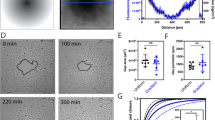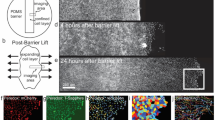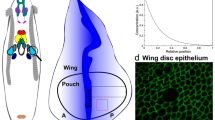Abstract
THE mouse cell line 3T3 ceases cell division at a confluent saturation density despite regular medium replacement. Also, when a confluent quiescent monolayer of 3T3 is wounded, cells migrate into the wound free of cell contact and initiate DNA synthesis, while cells in the monolayer remain arrested1. As the cells in both areas are in the same bulk medium, this experiment proves that depletion of growth factors in the bulk medium is itself not sufficient to account for density-dependent inhibition of growth. Two hypotheses have been proposed to explain the wounding experiment. The first states that direct cell–cell contact, perhaps involving the interaction of a receptor with its ligand on an adjacent cell, provides a negative signal for growth1. The second hypothesis states that growth ceases at a confluent cell density because of the establishment of a diffusion boundary layer which maintains the supply of one or more growth factors below a critical level2. A diffusion boundary layer results because convective movement of liquids near a solid surface approaches zero. In these conditions, the rate of delivery of molecules to and from the surface is limited by the rate of diffusion through the boundary layer. Increased fluid velocity on confluent cells causes initiation of DNA synthesis2,3, a finding apparently supporting the diffusion barrier hypothesis. Theoretically, increasing the fluid velocity over the cell layer should decrease the thickness of the hypothetical boundary layer and therefore increase the rate of delivery of a diffusion-limited growth-controlling substance4. However, in these experiments it was not possible to rule out an effect of fluid velocity on cell–cell contact. Yet if growth is a diffusion-limited process, then increasing viscosity of the cell culture medium should decrease the saturation density. We report here that increased viscosity has no effect on saturation density or on the rate of cell growth, providing strong evidence against the diffusion barrier hypothesis.
This is a preview of subscription content, access via your institution
Access options
Subscribe to this journal
Receive 51 print issues and online access
$199.00 per year
only $3.90 per issue
Buy this article
- Purchase on Springer Link
- Instant access to full article PDF
Prices may be subject to local taxes which are calculated during checkout
Similar content being viewed by others
References
Dulbecco, R. & Stoker, M. G. P. Proc. natn. Acad. Sci. U.S.A. 66, 204–210 (1970).
Stoker, M. G. P. Nature 246, 200–203 (1973).
Stoker, M. & Piggott, D. Cell 3, 207–215 (1971).
Levich, V. G. Physiochemical Hybrodynamics (Prentice Hall, New Jersey, 1962).
Barrow, G. M. Physical Chemistry (McGraw-Hill, New York, 1966).
Maroudes, N. G. Cell 3, 217–219 (1974).
de Petris, S. in Concanavalin A as a Tool (eds Higer, H. B. & Schnebli, H. P.) 95–116 (John Wiley, New York, 1976).
Whittenberger, B. & Glaser, L. Proc. natn. Acad. Sci. U.S.A. 74, 2251–2255 (1977).
Author information
Authors and Affiliations
Rights and permissions
About this article
Cite this article
WHITTENBERGER, B., GLASER, L. Cell saturation density is not determined by a diffusion-limited process. Nature 272, 821–823 (1978). https://doi.org/10.1038/272821a0
Received:
Accepted:
Published:
Issue Date:
DOI: https://doi.org/10.1038/272821a0
This article is cited by
-
New evidence that growth in 3T3 cell cultures is a diffusion-limited process
Nature (1984)
-
Density-dependent regulation of cell growth: An example of a cell-cell recognition phenomenon
The Journal of Membrane Biology (1981)
-
Cell density is determined by a diffusion-limited process (reply)
Nature (1979)
-
Cell density is determined by a diffusion-limited process
Nature (1979)
-
Pace of diffusion through membranes
The Journal of Membrane Biology (1979)
Comments
By submitting a comment you agree to abide by our Terms and Community Guidelines. If you find something abusive or that does not comply with our terms or guidelines please flag it as inappropriate.



